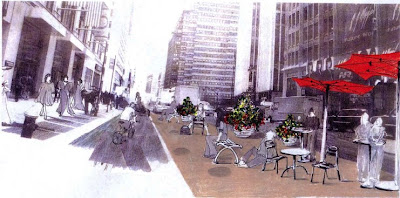 BBC photograph
BBC photographSo that you may not be the martyred slaves of Time, be drunk, be drunk without ceasing. With wine, with poetry, or with virtue, as per your taste.
They like to call themselves "The World's Greatest Classical Music Festival", and with 84 concerts over 8 weeks, who's to argue? And you can come, too!
The 2008 season of the London Proms
starts today, Friday, July 18th. Every concert can be heard live. Since they're six hours ahead of us, you can listen to evening concerts in the afternoon and the afternoon concerts at breakfast. Or you can catch up with them at your convenience - each concert will be available for internet streaming for seven days after.
76 of the events will take place at the massive , 5,500 seat
Royal Albert Hall (think
Bernard Herrmann conducting the orchestra in the climatic scene of Hitchcock's 1956 remake of
The Man Who Knew Too Much.)
 BBC photograph
BBC photographViolin virtuoso Nigel (the artist formerly known as) Kennedy kicked off this year's festival with "a unique performance of the
Dr Who theme music on the south steps of the Royal Albert Hall," complete with phone booth.
Last year, I caught on to this cornucopia rather late, but still heard an otherworldly performance of the Mahler 3rd with Claudio Abaddo conducting his Lausanne Festival Orchestra, and an almost impossibly blazing performance of the Shostakovich Tenth with wunderkind and LA Phil music director-designate Gustavo Dudamel leading the phenoms in his Simon Bolivar youth orchestra.
You can see the full listing for 2008
here. It's an amazing mix of beloved warhorses like the Brahms 2nd (concerto and symphony) and adventurous programming like major retrospectives of the work of centenarian
Elliot Carter and
Olivier Messiaen. (Prom 6 this coming Monday, July 21st, actually pairs
L'Ascension and
Et exspecto resurrectionem mortuorum with the Saint-Saens Organ symphony.) In addition to the aforementioned Nigel Kennedy, there's Pierre-Laurent Aimard, a Glyndebourne production of Monteverdi's
Coronation of Poppea, with Danielle De Niese
, a Stockhausen day on August 2nd
(Gruppen and
Stimmung), Leonard Slatkin conducting Adams, Bernstein and Ellington on August 8th, Barenboim conducting his West-Eastern Divan Orchestra in Schoenberg, Brahms and Boulez (the 14th), Pierre Boulez conducting Janacek - Sinfonietta, Concertino and the Glagolitic Mass - on the 15th, Gergiev conducting the complete
Sleeping Beauty on the 20th, the St. John Passion with John Elliot Gardner, Danielle Gatti, Lyric's own Sir Andrew Davis, Lorin Maazel and the NY Phil, The Berlin Phil Rattling the
Turangalila, prefectly preceded by the Tristan Prelude and Liebestod, on September 2nd, a complete
Saint Francis of Assisi, and, for the Last Night of the Proms, Bryn Terfel, Hélène Grimaud, and the BBC Symphony under Roger Norrington.
Not to be left out, the Chicago Symphony will be making appearances on September 8th and 9th with Bernard Haitink conducting the Mahler 6, Shostakovich 4th, and the Mozart c minor, K410 with Murray Perahia.
And that's just scratching the surface.
If all that doesn't leave your head spinning, well, I pity the fool, as a classical music addict might say. Check it all out
here.

 If Apple had come out with an iCar, this is what it might have looked like. Read all about the Metropolitan on Wikipedia here, and see a gallery of photo's here.
If Apple had come out with an iCar, this is what it might have looked like. Read all about the Metropolitan on Wikipedia here, and see a gallery of photo's here.







































